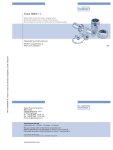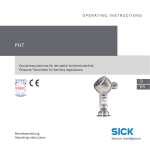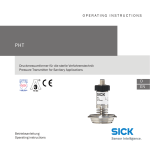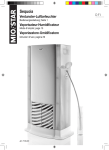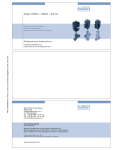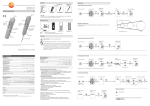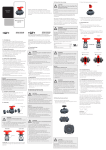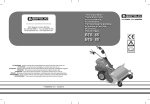Download Type BBS-3F - Bürkert Fluid Control Systems
Transcript
Type BBS-3F Inline inspection glass full view and standard design Linienschauglas Vollsicht und Standardausführung Indicateur de débit en ligne indication totale et modèle standard Operating Instructions Bedienungsanleitung Manuel d‘utilisation Bürkert Fluid Control Systems Sales Center Christian-Bürkert-Str. 13-17 D-74653 Ingelfingen Tel. + 49 (0) 7940 - 10 91 111 Fax + 49 (0) 7940 - 10 91 448 E-mail: [email protected] International address www.burkert.com → Bürkert → Company → Locations Manuals and data sheets on the Internet: www.burkert.com Bedienungsanleitungen und Datenblätter im Internet: www.buerkert.de Instructions de service et fiches techniques sur Internet : www.buerkert.fr © 2014 Bürkert Werke GmbH Operating Instructions 1402/00_EU-ML_00810320 / Original DE www.burkert.com Type BBS-3F 1. THE OPERATING INSTRUCTIONS The operating instructions contain important information. • Read the instructions carefully and follow the safety instructions in particular. • Keep the instructions in a location where they are available to every user. • The liability and warranty for the product do not apply if the procedures in the instructions are not observed. 1.1. Symbols →→designates a procedure which you must carry out. Warning of injuries: DANGER! Immediate danger! Serious or fatal injuries. WARNING! Possible danger! Serious or fatal injuries. CAUTION! Danger! Moderate or minor injuries. Warning of damage: NOTE! 2. INTENDED USE Non-authorized use of the Type BBS-3F inline inspection glass may be dangerous to people, nearby equipment and the environment. • Type BBS-3F has been designed as an inline inspection glass for pipelines for the flow of fluids in the sterile area. • Use according to the authorized data, operating conditions, and conditions of use specified in the contract documents and operating instructions. • Correct transportation, storage and installation, as well as careful use and maintenance are essential for reliable and faultless operation. • Use the product only as intended. 2.1. Restrictions If exporting the products, observe any existing restrictions. 2.2. Definitions of terms The term “product” used in these instructions always refers to the inline inspection glass Type BBS-3F. english 2 3. BASIC SAFETY INSTRUCTIONS 4. GENERAL INFORMATION These safety instructions do not take into account any contingencies and events which may arise during the installation, operation and maintenance of the product. 4.1. Contact address Danger – high pressure and discharge of medium! • Before loosening the nuts or screws, always turn off the pressure and relieve the lines. • Wear protective equipment if media is hazardous. General hazardous situations • Do not make any internal or external changes to the product. • Ensure that the system cannot be activated unintentionally. • Installation and maintenance work may be carried out only by authorized technicians with the appropriate tools. • The product may be operated only when in perfect condition and in consideration of the operating instructions. • As far as inspection, maintenance and repairs are concerned, observe national provisions of the country in which the connection elements are installed. • The general rules of technology apply to application planning and operation of the product. Germany Bürkert Fluid Control Systems Sales Center Christian-Bürkert-Str. 13-17 D-74653 Ingelfingen Tel. + 49 (0) 7940 - 10 91 111 Fax + 49 (0) 7940 - 10 91 448 E-mail: [email protected] International Contact addresses can be found on the final pages of the printed operating instructions. And also on the Internet at: www.burkert.com 4.2. Warranty The warranty is only valid if the product is used as intended in accordance with the specified application conditions. 4.3. Information on the Internet The operating instructions and data sheets for Type BBS-3F inline inspection glass can be found on the Internet at: www.burkert.com english 5. TECHNICAL DATA 5.1. Conformity The inline inspection glass Type BBS-3F conforms to the EC directives according to the EC Declaration of Conformity. 5.4. Sealing materials Seal material EPDM FKM Operating temperature –40 °C to 90 °C, briefly up to 140 °C –20 °C to 200 °C 5.2. Standards (if applicable) Tab. 1: Sealing materials BBS-3F inline inspection glass The applied standards which are used to demonstrate compliance with the EC Directives are listed in the EC type test certificate and/or the EC Declaration of Conformity. 5.5. General technical data 5.3. Identification Information on material, pipe and connection dimensions can be found on the stamping on the product. The identification number of the product can be found on the supplied 3.1 certificate. Material Fig. 1: 4 Material batch number Nominal connection diameter with pipe standard Example of identification of the product english comes into contact Stainless steel 1.4435 with medium BN2 (316L) does not comes into Stainless steel 1.4401 Material contact with medium or equivalent Glass Borosilicate glass O-ring EPDM/FKM Pipe dimensions see identification on product (“Fig. 1”) Permitted application Depending on sealing material, temperature see “Tab. 1” Ambient temperature –20 °C to +80 °C Media Fluids Operating pressure –1 to +8 bar (depending on the temperature) 3 Type BBS-3F 6. ASSEMBLY 6.1. Welding in the inline inspection glass NOTE! WARNING! Danger – high pressure and discharge of medium! • When working on the product or the system, always switch off the pressure and relieve the lines. • Wear protective equipment if media is hazardous. Risk of injury from improper assembly! • Installation must only be carried out by authorized technicians and with the appropriate tools! • Secure system from unintentional activation. Leak due to damaged sealing elements! • Do not weld in the assembled product. It is essential to remove the O-ring and glass tube before welding and to protect them from dust, flying sparks and other influences! Leak due to damaged sealing contour! • To ensure the sealing function, protect the sealing contour during installation, welding and cleaning procedures. →→Connect the parts positively in a protective gas shield. When cleaning the weld seam by grinding or acid cleaning, observe the following before assembling the connection: •Carefully remove all grinding dust and acid-cleaning residue. •Do not damage the label. •There must be no material abrasion on the sealing edges. Material abrasion will result in sharp-edged sealing contours and a damaged seal. •Check sealing contour for damage. We recommend preparing a welding report. english 6.2. Assembling orbital inline inspection glass 7 6 5 Fig. 2: 4 2 1 4 3 2 5 6 7 Assembling orbital inline inspection glass (with union nut) 6.3. Assembling standard inline inspection glass 5 Fig. 3: →→Insert both O-rings (2) by hand (do not use any tools or sharp implements) into the two designated grooves in the inspection glass holder (1). →→Carefully push glass (3) into the inspection glass holder. Ensure that the O-rings are in the correct position. →→Attach an O-ring (4) and a liner (5) to each side (do not use any tools or sharp implements) and secure with the union nuts (6). →→Tighten union nuts and secure with retaining rings (7). 5 4 2 1 2 3 4 5 Assembling standard inline inspection glass →→Insert both O-rings (2) by hand (do not use any tools or sharp implements) into the two designated grooves in the inspection glass holder (1). →→Carefully push glass (3) into the inspection glass holder. Ensure that the O-rings are in the correct position. →→Attach an O-ring (4) and a connecting piece (5) to each side (do not use any tools or sharp implements). →→Tighten connecting pieces. english 6 6.4. Assembling full view inline inspection glass 5 6 Fig. 4: 1 3 4 2 7 4 3 1 5 6 Assembling full view inline inspection glass →→In each flange (1) insert two O-rings (3 +4) by hand (do not use any tools or sharp implements). →→Push glass (7) into one of the two flanges. Ensure that the O-rings are in the correct position. →→Also insert spacer bolts (2) into the designated bores, secure with 7. START-UP WARNING! Risk of injury from improper operation! Improper operation may result in injuries as well as damage to the product and the surrounding area. • Before start-up, ensure that the operating personnel are familiar with and completely understand the contents of the operating instructions. • Observe the safety instructions and intended use. • Only adequately trained personnel may start up the equipment/the product. • Following assembly, ensure a controlled restart. • When starting up the equipment, ensure that no unauthorized voltage increases and pressure surges can occur. washers (5) and nuts (6). →→Attach second flange, secure with washers and nuts. →→Tighten nuts. 6.5. Disassembly Disassembly is in reverse sequence to assembly. english 7 Type BBS-3F 8. MAINTENANCE NOTE! Damage to the sealing elements when cleaning the pipeline systems. • Clean the pipeline systems preferably with a cleaning agent which does not damage the sealing elements. • Do not clean with wire brushes or machines which cause abrasion of the surface. • When using mechanical pipeline monitoring devices, ensure that they do not damage the sealing elements (also the sealing contour). Damaged sealing elements must be replaced! WARNING! Danger – high pressure and discharge of medium! • Before loosening the nuts or screws, always turn off the pressure and relieve the lines. • Wear protective equipment if media is hazardous. • Nuts or screws may be retightened on pressurized lines only by technicians in consideration of special precautions. • When shutting down the equipment, ensure that no unauthorized voltage increases and pressure surges can occur. • Following maintenance, ensure a controlled restart. Have the product serviced regularly by technicians! We recommend a maintenance interval of 6 months. Inspection and maintenance work includes in particular monitoring and ensuring the •leak-tightness, •identification, •proper mode of operation of the safety and warning devices. english 8 9. SPARE PARTS CAUTION! Risk of injury and/or damage by the use of incorrect parts! Incorrect accessories and unsuitable spare parts may cause injuries and damage the product and the surrounding area. • Use only original accessories and original spare parts from Bürkert. The spare part set for the inline inspection glass Type BBS-3F includes: O-rings, inspection glass The order numbers for the spare part sets can be found on the corresponding data sheet on the Internet. 10. TRANSPORTATION, STORAGE, DISPOSAL NOTE! Transport damage! Inadequately protected products may be damaged during transportation. • Transport the product in a firmly assembled state, protected against moisture and dirt, in shock-resistant packaging. Incorrect storage may damage the product. • Prevent the temperature from exceeding or dropping below the permitted storage temperature. • Store the product in a dry and dust-free location! • Store O-rings dry and protected from UV radiation and for not longer than 3 years. • Storage temperature –40 to +80 °C. Damage to the environment caused by products contaminated with media. • Dispose of the product and packaging in an environmentally friendly manner! • Observe applicable disposal and environmental regulations. english 9 Type BBS-3F Inline inspection glass full view and standard design Linienschauglas Vollsicht und Standardausführung Indicateur de débit en ligne indication totale et modèle standard Operating Instructions Bedienungsanleitung Manuel d‘utilisation Bürkert Fluid Control Systems Sales Center Christian-Bürkert-Str. 13-17 D-74653 Ingelfingen Tel. + 49 (0) 7940 - 10 91 111 Fax + 49 (0) 7940 - 10 91 448 E-mail: [email protected] International address www.burkert.com → Bürkert → Company → Locations Manuals and data sheets on the Internet: www.burkert.com Bedienungsanleitungen und Datenblätter im Internet: www.buerkert.de Instructions de service et fiches techniques sur Internet : www.buerkert.fr © 2014 Bürkert Werke GmbH Operating Instructions 1402/00_EU-ML_00810320 / Original DE www.burkert.com Typ BBS-3F 1. DIE BEDIENUNGSANLEITUNG Die Bedienungsanleitung enthält wichtige Informationen. • Anleitung sorgfältig lesen und besonders die Hinweise zur Sicherheit beachten. • Anleitung so aufbewahren, dass sie jedem Benutzer zur Verfügung steht. • Haftung und Gewährleistung für das Produkt entfällt, wenn die Anweisungen der Anleitung nicht beachtet werden. 1.1. Darstellungsmittel →→markiert einen Arbeitsschritt, den Sie ausführen müssen. Warnung vor Verletzungen: GEFAHR! Unmittelbare Gefahr! Schwere oder tödliche Verletzungen. WARNUNG! Mögliche Gefahr! Schwere oder tödliche Verletzungen. VORSICHT! Gefahr! Mittelschwere oder leichte Verletzungen. 2. BESTIMMUNGSGEMÄSSER GEBRAUCH Bei nicht bestimmungsgemäßem Gebrauch des Typs BBS-3F Linienschauglas können Gefahren für Personen, Anlagen in der Umgebung und die Umwelt entstehen. • Typ BBS-3F ist als Linienschauglas in Rohrleitungen zum Durchfluss von Fluiden im sterilen Bereich konzipiert. • Für den Einsatz die in den Vertragsdokumenten und der Bedienungsanleitung spezifizierten zulässigen Daten, Betriebs- und Einsatzbedingungen beachten. • Voraussetzungen für den sicheren und einwandfreien Betrieb sind sachgemäßer Transport, sachgemäße Lagerung und Installation sowie sorgfältige Bedienung und Instandhaltung. • Setzen Sie das Produkt nur bestimmungsgemäß ein. 2.1. Beschränkungen Bei der Ausfuhr der Produkte gegebenenfalls bestehende Beschränkungen beachten. 2.2. Begriffsdefinition Warnung vor Sachschäden: HINWEIS! Der in dieser Anleitung verwendete Begriff „Produkt“ steht immer für das Linienschauglas Typ BBS-3F. deutsch 10 3. GRUNDLEGENDE SICHERHEITSHINWEISE 4. ALLGEMEINE HINWEISE Diese Sicherheitshinweise berücksichtigen keine Zufälligkeiten und Ereignisse, die bei Montage, Betrieb und Wartung des Produkts auftreten können. Deutschland Bürkert Fluid Control Systems Sales Center Christian-Bürkert-Str. 13-17 D-74653 Ingelfingen Tel. + 49 (0) 7940 - 10 91 111 Fax + 49 (0) 7940 - 10 91 448 E-mail: [email protected] International Die Kontaktadressen finden Sie auf den letzten Seiten der gedruckten Bedienungsanleitung. Außerdem im Internet unter: www.burkert.com Gefahr durch hohen Druck und Mediumsaustritt! • Vor dem Lösen von Muttern oder Schrauben unbedingt den Druck abschalten und Leitungen entlasten. • Bei gefährlichen Medien Schutzausrüstung tragen. Allgemeine Gefahrensituationen • Am Produkt keine inneren oder äußeren Veränderungen vornehmen. • Beachten, dass die Anlage nicht unbeabsichtigt betätigt werden kann. • Installations- und Instandhaltungsarbeiten dürfen nur von autorisiertem Fachpersonal mit geeignetem Werkzeug ausgeführt werden. • Das Produkt nur in einwandfreiem Zustand und unter Beachtung der Bedienungsanleitung betreiben. • Bei Inspektion, Wartung und Instandsetzung nationale Bestimmungen des Aufstellungslands beachten. • Für die Einsatzplanung und den Betrieb des Produkts die allgemeinen Regeln der Technik einhalten. 4.1. Kontaktadresse 4.2. Gewährleistung Voraussetzung für die Gewährleistung ist der bestimmungsgemäße Gebrauch des Produkts unter Beachtung der spezifizierten Einsatzbedingungen. 4.3. Informationen im Internet Bedienungsanleitungen und Datenblätter zum Typ BBS-3F Linienschauglas finden Sie im Internet unter: www.buerkert.de deutsch 5. TECHNISCHE DATEN 11 5.4. Dichtungsmaterialien 5.1. Konformität Das Linienschauglas Typ BBS-3F ist konform zu den EG-Richtlinien entsprechend der EG-Konformitätserklärung. Dichtwerkstoff EPDM FKM Betriebstemperatur –40 °C bis 90 °C, kurzzeitig bis 140 °C –20 °C bis 200 °C 5.2. Normen (soweit anwendbar) Tab. 1: Dichtungsmaterialien BBS-3F Linienschauglas Die angewandten Normen, mit denen die Konformität mit den EG-Richtlinien nachgewiesen wird, sind in der EG-Baumusterprüfbescheinigung und/oder der EG-Konformitätserklärung nachzulesen. 5.5. Allgemeine technische Daten 5.3. Kennzeichnung Angaben zu Material, Rohr- und Anschlussmaß sind der Prägung auf dem Produkt zu entnehmen. Die Identnummer des Produkts entnehmen Sie bitte dem mitgelieferten 3.1-Zeugnis. Werkstoff Bild 1: 12 MaterialAnschlussnennweite chargennummer mit Rohrnorm Beispiel für die Kennzeichnung des Produkts deutsch Material mediumberührt Edelstahl 1.4435 BN2 (316L) nicht Edelstahl 1.4401 oder Ähnliches mediumberührt Glas Borosilikatglas O-Ring EPDM/FKM siehe Kennzeichnung auf Produkt („Bild 1“) je nach Dichtungsmaterial, siehe „Tab. 1“ Rohrmaße zulässige Einsatztemperatur Umgebungs–20 °C bis +80 °C temperatur Medien Fluide Betriebsdruck –1 bis +8 bar (in Abhängigkeit von Temperatur) Typ BBS-3F 6. MONTAGE 6.1. Einschweißen des Linienschauglases HINWEIS! WARNUNG! Gefahr durch hohen Druck und Mediumsaustritt! • Bei Arbeiten am Produkt oder der Anlage unbedingt den Druck abschalten und Leitungen entlasten. • Bei gefährlichen Medien Schutzausrüstung tragen. Verletzungsgefahr bei unsachgemäßer Montage! • Die Montage darf nur autorisiertes Fachpersonal mit geeignetem Werkzeug durchführen! • Anlage vor unbeabsichtigtem Betätigen sichern. Undichtheit durch beschädigte Dichtelemente! • Das Produkt nicht in zusammengebautem Zustand einschweißen. Vor dem Schweißen unbedingt O-Ring und Glasrohr entfernen und vor Staub, Funkenflug und anderen Einflüssen schützen! Undichtheit durch beschädigte Dichtkontur! • Zur Sicherstellung der Dichtfunktion die Dichtkontur während Montage, Schweißen und Reinigungsverfahren schützen. →→Verbindung formschlüssig unter Schutzgas heften. Bei Schweißnahtreinigung mittels Schleifen oder Beizen vor dem Zusammenbau der Verbindung beachten: •Alle Schleifstaub- und Beizereste sorgfältig entfernen. •Beschriftung nicht beschädigen. •An den Dichtkanten darf kein Materialabtrag vorgenommen werden. Materialabtrag führt zu scharfkantigen Dichtkonturen und damit zur Verletzung der Dichtung. •Dichtkontur auf Beschädigung kontrollieren. Wir empfehlen die Erstellung eines Schweißprotokolls. deutsch 6.2. Montage Linienschauglas orbital 7 6 5 Bild 2: 4 2 1 3 2 4 6.3. Montage Linienschauglas Standard 5 6 7 Montage LSG orbital (mit Überwurfmutter) 5 Bild 3: →→Beide O-Ringe (2) von Hand (keine Werkzeuge oder scharfen Hilfsmittel verwenden) in die beiden hierfür vorgesehenen Rillen im Schauglashalter (1) einlegen. →→Glas (3) vorsichtig in Schauglashalter schieben. Hierbei auf die korrekte Lage der O-Ringe achten. →→Von beiden Seiten je einen O-Ring (4) und einen Bundstutzen (5) anbringen (keine Werkzeuge oder scharfen Hilfsmittel verwenden) und durch die Überwurfmuttern (6) sichern. →→Überwurfmuttern festziehen und mit Sicherungsringen (7) sichern. 4 2 1 2 3 4 5 Montage LSG Standard →→Beide O-Ringe (2) von Hand (keine Werkzeuge oder scharfen Hilfsmittel verwenden) in die beiden hierfür vorgesehenen Rillen im Schauglashalter (1) einlegen. →→Glas (3) vorsichtig in Schauglashalter schieben. Hierbei auf korrekte Lage der O-Ringe achten. →→Von beiden Seiten je einen O-Ring (4) und einen Stutzen (5) anbringen (keine Werkzeuge oder scharfen Hilfsmittel verwenden). →→Stutzen festziehen. deutsch 14 7. INBETRIEBNAHME 6.4. Montage Linienschauglas Vollsicht 6 13 5 Bild 4: 1 3 4 2 7 4 3 1 5 6 Montage LSG Vollsicht →→In jeden Flansch (1) je zwei O-Ringe (3 +4) von Hand einlegen (keine Werkzeuge oder scharfen Hilfsmittel verwenden). →→Glas (7) in einen der beiden Flansche schieben. Hierbei auf die korrekte Lage der O-Ringe achten. →→Distanzbolzen (2) ebenfalls in die dafür vorgesehenen Bohrungen stecken, mit Unterlegscheiben (5) und Muttern (6) sichern. WARNUNG! Verletzungsgefahr bei unsachgemäßem Betrieb! Nicht sachgemäßer Betrieb kann zu Verletzungen sowie Schäden am Produkt und seiner Umgebung führen. • Vor der Inbetriebnahme muss gewährleistet sein, dass der Inhalt der Bedienungsanleitung dem Bedienungspersonal bekannt ist und vollständig verstanden wurde. • Die Sicherheitshinweise und der bestimmungsgemäße Gebrauch müssen beachtet werden. • Nur ausreichend geschultes Personal darf die Anlage/das Produkt in Betrieb nehmen. • Nach der Montage einen kontrollierten Wiederanlauf gewährleisten. • Anlage so in Betrieb nehmen, dass sich keine unzulässigen Spannungserhöhungen und Druckschläge ergeben können. →→Zweiten Flansch aufsetzen, mit Unterlegscheiben und Muttern sichern. →→Muttern festziehen. 6.5. Demontage Die Demontage erfolgt in umgekehrter Reihenfolge wie die Montage. deutsch 15 Typ BBS-3F 8. WARTUNG HINWEIS! Beschädigung der Dichtelemente beim Reinigen der Rohrleitungssysteme. • Zur Reinigung der Rohrleitungssysteme möglichst Reinigungsmittel verwenden, welche die Dichtelemente nicht beschädigen. • Zur Reinigung keine Drahtbürsten oder Maschinen benützen, die einen Oberflächenabtrag zur Folge haben. • Bei Verwendung mechanischer Rohrleitungs-Kontrollgeräte beachten, dass diese keine Beschädigung der Dichtelemente (auch der Dichtkontur) verursachen. Beschädigte Dichtelemente müssen ausgetauscht werden! WARNUNG! Gefahr durch hohen Druck und Mediumsaustritt! • Vor dem Lösen von Muttern oder Schrauben unbedingt den Druck abschalten und Leitungen entlasten. • Bei gefährlichen Medien Schutzausrüstung tragen. • An unter Druck stehenden Leitungen dürfen Muttern oder Schrauben nur von Fachpersonal unter Beachtung besonderer Vorsichtsmaßnahmen nachgezogen werden. • Anlage so abfahren, dass sich keine unzulässigen Spannungserhöhungen und Druckschläge ergeben können. • Nach der Wartung einen kontrollierten Wiederanlauf gewährleisten. Produkt regelmäßig durch fachkundiges Personal warten! Wir empfehlen einen Wartungsintervall von 6 Monaten. Zu den Inspektions- und Wartungsarbeiten gehören insbesondere die Überwachung und Sicherstellung der •Dichtheit, •Kennzeichnung, •ordnungsgemäßen Funktionsweise der Sicherheits- und Warneinrichtungen. deutsch 16 9. ERSATZTEILE VORSICHT! Verletzungsgefahr, Sachschäden durch falsche Teile! Falsches Zubehör und ungeeignete Ersatzteile können Verletzungen und Schäden am Produkt und dessen Umgebung verursachen. • Nur Originalzubehör sowie Original-Ersatzteile der Firma Bürkert verwenden. Das Ersatzteilset für das Linienschauglas Typ BBS-3F beinhaltet: O-Ringe, Schauglas Die Bestell-Nummern zu den Ersatzteil-Sets entnehmen Sie bitte dem entsprechenden Datenblatt im Internet. 10. TRANSPORT, LAGERUNG, ENTSORGUNG HINWEIS! Transportschäden! Unzureichend geschützte Produkte können durch den Transport beschädigt werden. • Produkt in fest zusammengesetztem Zustand vor Nässe und Schmutz geschützt in einer stoßfesten Verpackung transportieren. Falsche Lagerung kann Schäden am Produkt verursachen. • Eine Über- bzw. Unterschreitung der zulässigen Lagertemperatur vermeiden. • Produkt trocken und staubfrei lagern! • O-Ringe trocken und vor UV-Strahlung geschützt und nicht länger als 3 Jahre lagern. • Lagertemperatur –40 … +80 °C. Umweltschäden durch von Medien kontaminierte Produkte. • Produkt und Verpackung umweltgerecht entsorgen! • Geltende Entsorgungsvorschriften und Umweltbestimmungen einhalten. deutsch 17 Type BBS-3F Inline inspection glass full view and standard design Linienschauglas Vollsicht und Standardausführung Indicateur de débit en ligne indication totale et modèle standard Operating Instructions Bedienungsanleitung Manuel d‘utilisation Bürkert Fluid Control Systems Sales Center Christian-Bürkert-Str. 13-17 D-74653 Ingelfingen Tel. + 49 (0) 7940 - 10 91 111 Fax + 49 (0) 7940 - 10 91 448 E-mail: [email protected] International address www.burkert.com → Bürkert → Company → Locations Manuals and data sheets on the Internet: www.burkert.com Bedienungsanleitungen und Datenblätter im Internet: www.buerkert.de Instructions de service et fiches techniques sur Internet : www.buerkert.fr © 2014 Bürkert Werke GmbH Operating Instructions 1402/00_EU-ML_00810320 / Original DE www.burkert.com Type BBS-3F 2. UTILISATION CONFORME 1. MANUEL D'UTILISATION Le manuel d'utilisation contient des informations importantes. • Lire attentivement le manuel d'utilisation et tenir particulièrement compte des consignes de sécurité. • Conserver le manuel d'utilisation afin qu'il soit accessible à tous les utilisateurs. • La responsabilité et la garantie légale concernant le produit sont exclues en cas de non-respect du manuel d'utilisation. 1.1. Symboles →→identifie une opération que vous devez effectuer. L'utilisation non conforme de l'indicateur de débit en ligne de Type BBS-3F peut présenter des dangers pour les personnes, les installations proches et l'environnement. • Le Type BBS-3F est conçu comme indicateur de débit en ligne installé dans la tuyauterie pour observer le débit de fluides en milieu stérile. • Lors de son utilisation, il convient de respecter les données et conditions d'utilisation et d'exploitation admissibles spécifiées dans le manuel d'utilisation et dans les documents contractuels. • Les conditions pour l'utilisation sûre et parfaite sont un transport, un stockage et une installation dans les règles ainsi qu'une utilisation et une maintenance parfaites. • Veillez à ce que l'utilisation du produit soit toujours conforme. Mise en garde contre les blessures : DANGER ! Danger imminent ! Blessures graves ou mortelles. AVERTISSEMENT ! Danger potentiel ! Blessures graves ou mortelles. ATTENTION ! Danger ! Blessures légères ou de moyenne gravité. 2.1. Limitations Mise en garde contre les dommages matériels : REMARQUE ! Le terme « produit » utilisé dans ce manuel désigne toujours l'indicateur de débit en ligne Type BBS-3F. Lors de l'exportation des produits, veuillez respecter les limitations éventuelles existantes. 2.2. Définition des termes français 18 3. CONSIGNES DE SÉCURITÉ FONDAMENTALES 4. INDICATIONS GÉNÉRALES Ces consignes de sécurité ne tiennent pas compte des hasards et des événements pouvant survenir lors du montage, de l'exploitation et de la maintenance du produit. Allemagne Bürkert Fluid Control Systems Sales Center Christian-Bürkert-Str. 13-17 D-74653 Ingelfingen Tél. + 49 (0) 7940 - 10 91 111 Fax + 49 (0) 7940 - 10 91 448 E-mail: [email protected] International Les adresses figurent aux dernières pages de la version imprimée du manuel d'utilisation. Également sur Internet sous : www.burkert.com Danger dû à la pression élevée et à la sortie de fluide ! •Avant de desserrer les écrous ou les vis, couper impérativement la pression et purger l'air des conduites. •En cas d'utilisation de fluides toxiques, porter l'équipement de protection. Situations dangereuses d’ordre général •N’apportez pas de modifications internes ou externes au produit. •L’actionnement par inadvertance de l’installation ne doit pas être possible. •Les travaux d’installation et de maintenance doivent être effectués uniquement par des techniciens qualifiés et habilités disposant de l’outillage approprié. •Le produit doit être utilisé uniquement en parfait état et en respectant le manuel d’utilisation. •Respecter les dispositions nationales en vigueur dans le pays d’installation lors de l’inspection, de la maintenance et de la réparation. •Les règles générales de la technique sont d’application pour planifier l’utilisation et utiliser le produit. 4.1. Adresse 4.2. Garantie légale La condition pour bénéficier de la garantie légale est l'utilisation conforme du produit dans le respect des conditions d'utilisation spécifiées. 4.3. Informations sur Internet Vous trouverez sur Internet les manuels et fiches techniques relatives à l'indicateur de débit en ligne Type BBS-3F : www.buerkert.fr français 5. CARACTÉRISTIQUES TECHNIQUES 5.1. Conformité L'indicateur de débit en ligne Type BBS-3F répond aux directives CE conformément à la déclaration de conformité CE. 19 5.4. Matériaux d'étanchéité Matériau du joint EPDM FKM Température de service -40 à 90 °C, brièvement jusqu'à 140 °C -20 à 200 °C 5.2. Normes (si applicables) Tab. 1: Matériaux d'étanchéité de l'indicateur de débit en ligne Type BBS-3F Les normes utilisées attestant de la conformité avec les directives CE figurent dans l'attestation CE de type et/ou la déclaration de conformité CE. 5.5. Caractéristiques techniques générales 5.3. Identification Les informations concernant le matériau, la dimension du tube et le raccordement sont gravées sur le produit. Vous trouverez le numéro d'identification du produit dans le certificat 3.1 fourni. Matériau Fig. 1: 20 Numéro de lot matériau Diamètre nominal de raccordement avec norme de tube Matériau en contact avec Acier inoxydable 1.4435 le fluide BN2 (316L) non en contact Acier inoxydable 1.4401 avec le fluide ou similaire Verre Verre au borosilicate Joint torique EPDM/FKM Voir identification sur le produit (« Fig. 1 ») selon le matériau d'étanchéité, voir « Tab. 1 » Dimensions du tube Température d'utilisation admissible Température ambiante -20 °C à +80 °C Fluides Fluides Pression de service -1 à +8 bars (en fonction de la température) Exemple d'identification du produit français Type BBS-3F 6. MONTAGE 6.1. Soudage de l'indicateur de débit en ligne REMARQUE ! AVERTISSEMENT ! Danger dû à la pression élevée et à la sortie de fluide ! • Couper impérativement la pression et dépressuriser les conduites lors des travaux sur le produit ou l'installation. • En cas d'utilisation de fluides toxiques, porter l'équipement de protection. Risque de blessures dû à un montage non conforme ! • Le montage doit être effectué uniquement par des techniciens qualifiés et habilités disposant de l'outillage approprié ! • Empêcher tout actionnement involontaire de l'installation. Fuites dues à des éléments d'étanchéité endommagés ! • Ne pas souder le produit lorsqu'il est assemblé. Avant les travaux de soudage, retirer impérativement le joint torique et le tube en verre, et les protéger de la poussière, des étincelles et d'autres éléments ! Fuites dues à un contour d'étanchéité endommagé ! • Pour garantir la fonction d'étanchéité, protéger le contour d'étanchéité pendant le montage, le soudage et le nettoyage. →→Pointer le raccord sur toute sa surface sous gaz protecteur. Lors du nettoyage de la soudure par meulage ou décapage, veiller avant l'assemblage du raccord à : •Retirer soigneusement tous les résidus de poussière de meulage et de décapage. •Ne pas endommager les inscriptions. •Aucun enlèvement de matière ne doit être effectué au niveau des bords d'étanchéité. L'enlèvement de matière génère des contours d'étanchéité à arêtes vives endommageant le joint. •Contrôler la présence de dommages sur le contour d'étanchéité. Nous recommandons d'établir un rapport de soudage. français 6.2. Montage orbital de l'indicateur de débit en ligne 7 6 5 Fig. 2: 4 2 1 3 2 4 5 6 7 Montage orbital de l'indicateur de débit en ligne (avec écrou-raccord) →→Insérer les deux joints toriques (2) à la main (ne pas utiliser d'outil ou d'objet tranchant) dans les deux rainures prévues à cet effet situées dans le support de l'indicateur (1). →→Insérer avec précaution le verre (3) dans le support. Veiller à la position correcte des joints toriques. →→Poser un joint torique (4) et un raccord à collet (5) des deux côtés (ne pas utiliser d'outil ou d'objet tranchant) et bloquer à l'aide des écrous-raccords (6). →→Serrer les écrous-raccords et bloquer à l'aide des bagues de sécurité (7). 21 6.3. Montage de l'indicateur de débit en ligne standard 5 Fig. 3: 4 2 1 2 3 4 5 Montage de l'indicateur de débit en ligne standard →→Insérer les deux joints toriques (2) à la main (ne pas utiliser d'outil ou d'objet tranchant) dans les deux rainures prévues à cet effet situées dans le support de l'indicateur (1). →→Insérer avec précaution le verre (3) dans le support. Veiller à la position correcte des joints toriques. →→Poser un joint torique (4) et un raccord (5) des deux côtés (ne pas utiliser d'outil ou d'objet tranchant). →→Serrer les raccords. français 22 6.4. Montage de l'indicateur de débit en ligne indication totale 5 6 Fig. 4: 1 3 4 2 7 4 3 5 1 6 Montage de l'indicateur de débit en ligne indication totale →→Insérer dans chaque bride (1) respectivement deux joints toriques (3 + 4) à la main (ne pas utiliser d'outil ou d'objet tranchant). →→Insérer avec précaution le verre (7) dans les deux brides. Veiller à 7. MISE EN SERVICE AVERTISSEMENT ! Risque de blessures en cas d'utilisation non conforme ! Une utilisation non conforme peut entraîner des blessures et endommager le produit et son environnement. • Avant la mise en service, il faut s'assurer que le contenu du manuel d'utilisation est connu et parfaitement compris par les opérateurs. • Respecter les consignes de sécurité et l'utilisation conforme. • L'installation/le produit doit être mis(e) en service uniquement par un personnel suffisamment formé. • Garantir un redémarrage contrôlé après le montage. • Mettre l'installation en service en veillant à empêcher les augmentations de tension et les coups de bélier inadmissibles. la position correcte des joints toriques. →→Placer également les boulons d'écartement (2) dans les orifices prévus, bloquer à l'aide des rondelles (5) et des écrous (6). →→Placer la deuxième bride, bloquer avec les rondelles et écrous. →→Serrer les écrous. 6.5. Démontage Le démontage a lieu dans le sens inverse du montage. français 23 Type BBS-3F 8. MAINTENANCE REMARQUE ! Endommagement des éléments d'étanchéité lors du nettoyage des systèmes de tuyauterie. • Pour nettoyer les systèmes de tuyauterie, utiliser dans la mesure du possible des produits de nettoyage n'endommageant pas les éléments d'étanchéité. • Pour le nettoyage, ne pas utiliser de brosses métalliques ou de machines attaquant la surface. • Si vous utilisez des appareils de contrôle mécaniques pour tuyauteries, veiller à ce que ceux-ci n'endommagent pas les éléments d'étanchéité (ni le contour d'étanchéité). Les éléments d'étanchéité endommagés doivent être remplacés ! AVERTISSEMENT ! Danger dû à la pression élevée et à la sortie de fluide ! • Avant de desserrer les écrous ou les vis, couper impérativement la pression et purger l'air des conduites. • En cas d'utilisation de fluides toxiques, porter l'équipement de protection. • Seuls les techniciens qualifiés sont autorisés à resserrer écrous et vis sur les tuyauteries sous pression en respectant les mesures de sécurité spécifiques. • Mettre l'installation hors service en veillant à empêcher les augmentations de tension et les coups de bélier inadmissibles. • Garantir un redémarrage contrôlé après la maintenance. Faire effectuer régulièrement l'entretien du produit par un personnel spécialisé ! Nous recommandons de respecter une périodicité de maintenance de 6 mois. Font notamment partie des travaux d'inspection et de maintenance, la surveillance et la garantie de •l'étanchéité, •l'identification, •et le parfait fonctionnement des dispositifs de sécurité et d'avertissement. français 24 10. TRANSPORT, STOCKAGE, ÉLIMINATION 9. PIÈCES DE RECHANGE ATTENTION ! REMARQUE ! Risque de blessures, de dommages matériels dus à de mauvaises pièces ! De mauvais accessoires ou des pièces de rechange inadaptées peuvent provoquer des blessures et endommager le produit ou son environnement. • Utiliser uniquement des accessoires et des pièces de rechange d'origine de la société Bürkert. Le kit de pièces de rechange pour l'indicateur de débit en ligne Type BBS-3F contient : joints toriques, indicateur Les numéros d'article des jeux de pièces de rechange sont indiqués sur la fiche de données correspondante sur Internet. français Dommages dus au transport ! Les produits insuffisamment protégés peuvent être endommagés pendant le transport. • Transporter le produit, bien assemblé, à l'abri de l'humidité et des impuretés et dans un emballage résistant aux chocs. Un mauvais stockage peut endommager le tamis filtrant. • Éviter le dépassement vers le haut ou le bas de la température de stockage admissible. • Stocker le produit au sec et à l'abri des poussières ! • Stocker les joints toriques au sec et à l'abri des UV, la durée de stockage ne devant pas dépasser 3 ans. • Température de stockage -40 à +80 °C. Dommages sur l'environnement causés par des produits contaminées par des fluides. • Éliminer le produit et l'emballage dans le respect de l'environnement ! • Respecter les prescriptions en matière d'élimination des déchets et de protection de l'environnement en vigueur. 25












